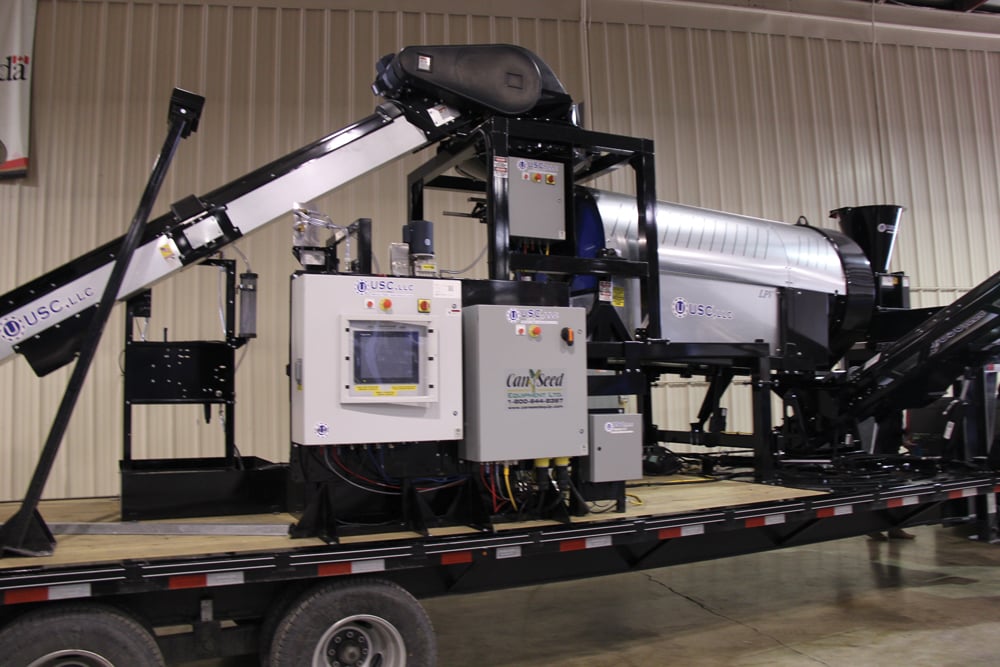When should farmers consider buying their own seed treaters? It’s a question growers were likely pondering during Bayer’s SeedGrowth Solutions Expo in Saskatoon in late March.
Brian Ellis, a pedigreed seed grower from Olds, Alberta, said farmers who buy certified seed each year can likely get treated seed from a seed grower. But those who are cleaning and using some of their own seed might want to have their own seed-treating systems. In those cases, a 1,000 acre farm can probably justify spending $5,000 on a good quality seed treater, he added.
Read Also

Claas brings 1000 Series SP forage harvesters to Canada
In mid-August, Claas unveiled its new line of Jaguar forage harvesters at an event in Visalia, California, deep in the heart of that state’s dairy region.
Ellis also runs Graham Seeding Treating Systems, a company originally started by his neighbour about 18 years ago. It offers a range of equipment suited to different-sized operations. Ellis had a display set up at the Saskatoon show.
“We have packages for very small growers, hobby farmers. Entry-level type treaters for guys that are making the step up from drippers to a better treating system, all the way up to our 40 to 50 bushel a minute treaters,” Ellis said.
Packages start at about $1,000. Those entry-level packages are “definitely a step in the right direction,” he added, and they can be upgraded later on. The company’s G40 package will treat 40 bushels of wheat and 50 bushels of barley per minute. It sells in the $8,000 range.
G40 packages include a transfer auger, with a seed flow control kit to regulate grain flow to the treater. Farmers can also mount the applicator to the bottom of the hopper bin. The G40 package allows for a single product application at a time, Ellis said, although farmers can also tank-mix micronutrients with the seed treatment.
“If they prefer to keep those products separate, we do have a double-chute addition, so we can apply two products sequentially through two separate nozzles,” he added.

More seed treaters for the average farm
Ellis wasn’t the only one with an on-farm seed treatment system on display at the Expo. Chris Larsen, who handles seed treater sales for Ag Growth International (AGI), also had seed treatment systems on-site.
AGI’s 1041 Storm is aimed at the typical farmer who’s treating seed on-farm and uses an auger-style seed treatment system.
“What’s unique about Storm is our ability to meter directly from a bin,” said Larsen. “We fit seed-treating into an all-in-one process. We accurately metre through volumetric conveyance.”
Proprietary software makes seed treatment “very easy for the user. It takes what used to be a very dirty and messy job — an undesirable job — and turns it into an easy job.”
The 1041 Storm will treat 1800 pounds of grain an hour, or about 30 bushels a minute. And farmers can apply two products simultaneously.
Larsen added that the system uses volumetric conveyance, which relies on the density of the seed. “We built mathematical curves based on wheat, barley, oats, peas, lentils, and flax.” By entering a density into the electronics, AGI guarantees the 1041 Storm will deliver within three per cent. “So you ask the machine to treat 50,000 pounds, it treats 50,000 pounds and shuts off.”
Can-Seed Equipment’s Jason MacNevin was also on-hand to show USC’s LPH800 seed treater. The drum seed treatment system can treat roughly 750 bushels per hour, and it’s meant for an average farm. The price point is comparable to an auger-style seed treater, he said.
Features include a manual control panel that allows farmers to dial in the chemical rate. It also has an atomizer chamber. “The seed will flow in, in a cone, and spread out. And 99 per cent of the seed will get treated in the atomizer chamber,” he said. Farmers can apply up to four products at once.

















